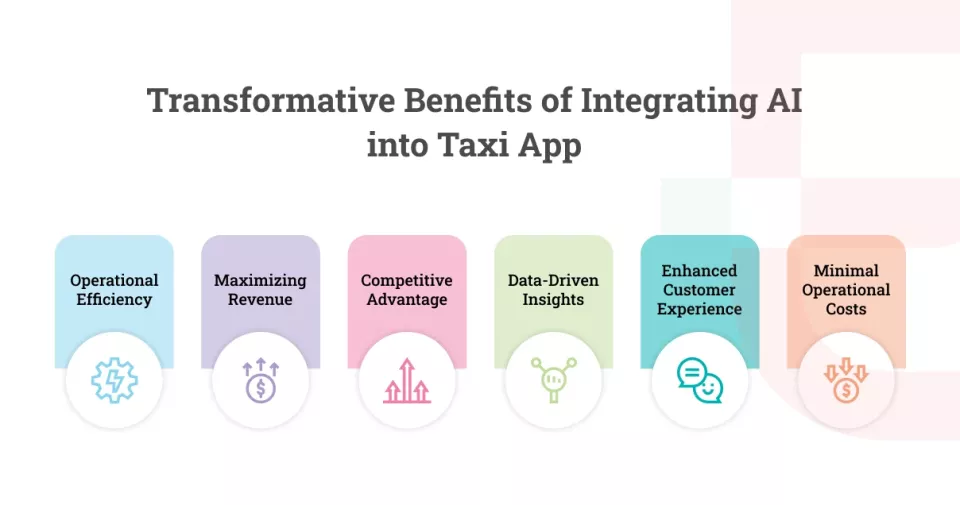
In this digital era, we have witnessed a significant shift in the overall taxi industry, driven by the rise of on-demand mobility and the growing number of ride-hailing apps. What started as a simplified way to book a trip has evolved into a more advanced process, and all thanks to AI. Businesses are increasingly investing in AI features for taxi app to enhance operations and deliver an exceptional customer experience.
- Top 10 Must-Have AI Features in Taxi App to Elevate Your Business
- 1. Dynamic Route Optimization
- 2. Smart Ride Matching
- 3. Predictive Demand Forecasting
- 4. Dynamic Pricing Engine
- 5. Voice and Chatbot Assistance
- 6. AI-Powered Safety Features
- 7. Predictive Fleet Health Management
- 8. Personalized User Experience Engine
- 9. Driver Performance Analytics
- 10. AI-Powered Booking Assistant
- Why Artificial Intelligence is a Game-Changer for Taxi App – Let’s Explore Its Transformative Benefits
- Conclusion
- FAQs
Nowadays, many taxi businesses have doubts about which AI features will bring value to their business, and if you are also one of them, then this comprehensive blog is for you. We have effectively outlined the top AI features for taxi app solutions and highlighted the benefits that help modern taxi apps remain competitive in the evolving market.
Top 10 Must-Have AI Features in Taxi App to Elevate Your Business
Let’s explore the 10 must-have AI features in taxi app that help businesses overcome their challenges in real-time while staying competitive in this evolving mobility market.
1. Dynamic Route Optimization
Dynamic route optimization is one of the key AI features for taxi app, among others.
Despite relying on static maps or GPS routing, this AI-powered feature analyzes multiple factors, including traffic data, weather conditions, and road closures, to recommend the most efficient route for each trip. This ensures drivers can reach their destinations faster by avoiding delays caused by unpredictable conditions.
Moreover, with this fuel-efficient route optimization, businesses can save money on operational expenses while maintaining their fleets more efficiently. It also delivers customers a faster, smoother ride experience, resulting in enhanced overall satisfaction and loyalty.
2. Smart Ride Matching
Dispatching trips manually to nearby drivers sometimes does not work effectively, leaving customers without service. However, this smart ride-matching uses AI algorithms to analyze multiple factors, including driver availability, traffic, and customer preferences, to connect riders with the most suitable drivers.
This AI-driven functionality enables businesses to optimize their drivers and fleets effectively. It not only helps them boost ride completion rates, resulting in stronger overall operations that scale more effectively, but also offers both customers and drivers a more seamless and engaging ride-hailing experience.
3. Predictive Demand Forecasting
Meeting customer demand requires careful planning, especially during peak hours. Recognized as one of the must-have AI features in taxi app, predictive demand forecasting uses historical and real-time data to determine peak-demand hours and areas, and to set vehicle and driver availability to optimize it effectively.
This foresight enables drivers to be strategically positioned in high-demand areas, enabling them to complete trips promptly and earn an additional source of income. It also helps businesses anticipate demand, enabling them to deliver consistent service even during peak hours, minimizing the risk of missing trips.
4. Dynamic Pricing Engine
Nowadays, one of the key features every ride-hailing business demands is a dynamic pricing engine. Before the advent of AI, businesses had to update prices manually whenever market demand surged. However, by adopting artificial intelligence, fares are adjusted based on demand, driver availability, and other factors, eliminating the need for manual price updates.
This ensures transparent and fair pricing for riders while motivating drivers to stay active during peak hours to earn extra revenue. Additionally, it enables businesses to balance customer affordability with profitability.
5. Voice and Chatbot Assistance
Handling customers’ endless queries is not only costly but also time-consuming. With the help of an AI-powered chatbot solution and a voice assistant, it directly addresses customer queries, supports them in cancelling their rides, and makes the interaction natural, making this one of the top AI features for a taxi app.
From delivering 24/7 support to offering immediate responses, it makes customers’ experiences smooth and convenient. At the same time, it reduces businesses’ workload by automating assistance, helping them stay ahead in this competitive market and build a strong customer base.
6. AI-Powered Safety Features
Customers’ and drivers’ safety is the top priority in the taxi industry, and AI plays a vital role in enhancing it. From real-time monitoring of drivers’ behavior to facial recognition, among other AI-powered functionalities, it effectively protects both customers and drivers from unexpected situations.
With these AI features for taxi app, businesses can offer a more secure trip experience while fostering customer loyalty.
7. Predictive Fleet Health Management
For every taxi business, taking effective care of its fleet is crucial, and AI-powered capabilities help achieve this through predictive fleet health management. It analyzes overall vehicle data, such as usage and last maintenance gaps, detects early warning signs, and schedules maintenance before breakdowns occur.
This significantly reduces last-minute maintenance costs, extends vehicle lifespan, and improves overall operational efficiency without disrupting customers’ trips, providing a smooth ride experience. According to the latest report, the global smart fleet management market is expected to reach USD 804.17bn by 2030, highlighting the growing importance of predictive technologies in modern mobility solutions.
8. Personalized User Experience Engine
In the modern era, customers prefer platforms that offer personalization, and taxi app are no exception. Thus, leveraging AI-powered capabilities to deliver a tailored experience is the best choice for businesses. It easily analyzes customers’ behaviour, booking habits, and preferences based on their past trip history to recommend preferred vehicle types, routes, and more.
Recognized as one of the top AI features for taxi app, as it not only delivers a tailored trip experience to customers but also helps businesses boost their customer retention.
9. Driver Performance Analytics
Drivers are the backbone of every taxi business, and staying in tune with their performance is a crucial part of every entrepreneur’s role. This is where AI-driven functionality caught the attention! It helps businesses easily track drivers’ overall performance by monitoring their rides, completed trips, driving patterns, and customer feedback.
It enables businesses to recognize top-performing drivers and quickly address performance gaps. This helps them maintain high service standards while reducing complaints, ultimately delivering safe trip services to customers.
10. AI-Powered Booking Assistant
The more streamlined booking process you establish, the greater the number of customers you will attract; this is what this AI will facilitate for your taxi app. This AI-driven feature offers a quick, intuitive, and conversational booking option. It allows customers to book or schedule their rides by speaking or typing, and the AI assistant handles the rest.
This results in prompt ride confirmation with fewer errors, making it a more preferred choice for customers while booking. Additionally, it helps businesses improve booking accuracy by providing a convenient customer experience.
Maximize Your Business Revenue and Build a Strong Customer Base by Integrating AI Features into Your Taxi App.
Why Artificial Intelligence is a Game-Changer for Taxi App – Let’s Explore Its Transformative Benefits
Over the years, people have witnessed significant changes in ride-hailing standards, with technology playing a crucial role in this evolution. Gone are the days when people had to follow a frustrating process to book a taxi, thanks to upgraded and AI-based technologies.
Today, people are opting more for digital taxi apps, as they not only provide easy access to reserve a ride but also offer a customized trip experience, available from anywhere, at any time. In fact, more entrepreneurs are adopting AI features for taxi app to leverage advanced benefits, such as demand forecasting, automated customer support, and improved scalability.
Aside from this, the following are key benefits a business can gain by incorporating the top AI features into its ride-hailing platform.

Operational Efficiency
Businesses operating AI-powered taxi app achieve remarkable growth and efficiency by automating most of their repetitive tasks. This includes driver allocation, customer query resolution, fleet maintenance, and more, enabling businesses to optimize resources and streamline operations.
Maximizing Revenue
One of the major benefits a business can gain from integrating AI features into its ride-hailing platform is increased revenue. It optimizes routes, automates dynamic pricing, and enhances fleet utilization, enabling businesses to significantly boost revenue.
Competitive Advantage
Businesses that invest in an AI-powered taxi app will gain a competitive advantage through smart ride matching and demand forecasting, as well as personalized ride experiences and fleet maintenance. This AI functionality helps businesses drive growth while enabling easy expansion by keeping them up to date with market trends.
Data-Driven Insights
With AI, businesses can easily generate data-driven insights into their overall business operations. From gathering data on overall trip completion and earnings to future trends, helping businesses make strategic decisions that drive significant growth.
Enhanced Customer Experience
An advanced AI feature easily enhances customers’ overall experience. It provides riders with a personalized experience and delivers 24/7 customer support, updating them in real time on their trip status.
Minimal Operational Costs
AI significantly reduces businesses’ overall operational costs by predicting maintenance needs, optimizing routes, and automating customer support. This reduces fuel costs, eliminates repetitive tasks, and delivers an efficient customer experience.
Conclusion
In the modern mobility market, integrating AI is not optional; it is mandatory for the taxi industry to remain competitive. Thus, through this comprehensive blog, we have provided a list of essential AI features for taxi app that every entrepreneur must consider adding to their solution to enhance efficiency, improve customer satisfaction, and maximize profitability.
Now, if you are also looking to bring AI features to your ride-hailing platform, connecting with our AI development services would be an ideal choice for your business. We have a team of AI experts who will help you incorporate all required AI features into your taxi app, making your business more profitable and future-ready.
FAQs
The cost of developing an AI-powered taxi app typically ranges from $50,000 to $150,000. However, several factors impact the final costing, including the level of AI integration, overall project complexity, size & location of the development team, and other customization needs.
AI integration is crucial because it can effectively address the key pain points of the taxi industry. It enables businesses to predict demand, optimize routes in real time, automate dynamic pricing during peak hours, and provide a personalized experience. This results in improved operational efficiency, reduced costs, and a more convenient trip for customers.
At the time of implementing AI in a taxi app, businesses encounter several major challenges, including high-quality data privacy & security, the complexity of integrating it with existing systems, and increased development costs, among others.
Below, we have provided a list of several promising future trends of AI in the taxi industry, including:
- Autonomous taxis
- Hyper-personalized user experience
- Predictive vehicle maintenance
- AI-powered safety, etc.






